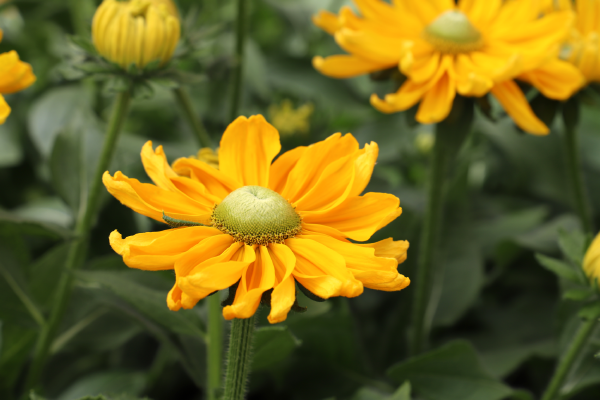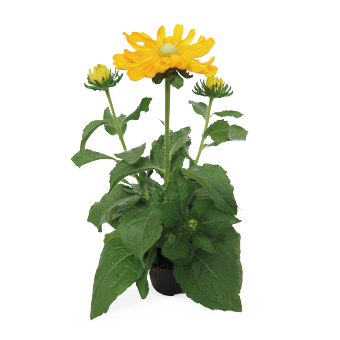

Amarillo Gold
Item no.: RH0501PSymbol of the Summer
- FleuroSelect Gold Medal and AAS award winner
- Perfect for pot and bedding plant production
- Huge, bright flowers on short stems
- Compact sister of Prairie Sun
- Crop Time
- Spring: 13 - 15 weeks , Summer: 12 - 14 weeks
- Height ∅
- 14 ″ / 35 cm
- Width ∅
- 11 ″ / 28 cm
- Flower Size ∅
- 6 ″ / 16 cm
- Exposure
- Sun
- Seed Form
- BeGreen Pelleting
- Product Use
- Borders, Pots, Containers, Cutflower
- Family, Origin
- Asteraceae, North America
- Minimum Germ. Rate
- 90 %
Technical Guide
Flowering Type: Obligate long day plant; a day length > 13 hrs., with 6-8 true leaves will result in flower initiation.
Flowering Mechanism: Primary mechanism is long days and maturity. Short days (< 13,5 hours) can be used for bulking Rudbeckia vegetatively and keeping the finishing height of the plants shorter.
Germination: Optimal conditions for seedling development,should begin on the day of sowing until root emergence. Expect root emergence in 10-14 days depending on temperature and moisture.
Cover: No cover is necessary however a light covering of vermiculite will aid in maintaining proper moisture and humidity levels during germination.
Sowing method: 1-2 seeds per plug. Can also be sown directly into the final container.
Media: A media with a pH 6.0-6.2. EC <1.0; that is low in soluble salts. Avoid media compaction to aid in root penetration.
Temperature: Maintain 20-23 °C (68-74 °F).
Moisture: Begin with a moisture level slightly higher than a wet (4) for the first 14 days or until root emergence has occurred. On day 15 begin to dry back the media slightly. Alternate between a moisture level wet (4) and a medium (3).
Humidity: 95-100 % until day 11; then reduce to 40-60 %. Provide proper ventilation and horizontal airflow to improve oxygen levels in the media.
Light: Light is necessary for germination so if using a germination chamber provide 10-100 ft. candles (100-1,000 lx). Supplemental lighting is beneficial. Keep day length less than 13 hrs. for the first 4-5 weeks to keep the seedlings from premature flower initiation. This is more critical after germination has occurred and seedlings are further developed.
Fertilizer: Maintain an EC < 1.0. Begin feeding once germination is complete or on approximately day 14. Fertilize with a calcium-based feed; 14-4-14, 17-5-17 or similar at 50 ppm N.
Plug Bulking and Flower Initiation: Maintain optimal conditions during the vegetative stage from cotyledon expansion to flower initiation. When the seedlings root to the edge of the plug and reach the 6-8 true leaf stage flower initiation will occur.
Media: pH 6.0-6.2; EC 1.0-1.5.
Light: Provide light levels between 8-16 mol/m² / day (2,500-4,500 ft. candles or 25,000-45,000 lx). Continue to keep the day length less than 13 hrs. for the first 4-5 weeks or until the plants reach the 6-8 true leaf stage.
Temperature: Maintain 18-20 °C (64-68 °F).
Moisture: Alternate between moisture levels wet (4) and moist (3). Allow the media to reach a moist (3) before re-saturating to a wet (4).
Fertilizer: Rudbeckia require a moderate feed program using a well balanced fertilizer. Fertilize with a calcium based feed, 14-4-14 or 17-5-17 at 50-100 ppm N. Under higher light conditions an occasional feeding with a fertilizer having a higher nitrogen level can be used; 20-10-20 at 100 ppm N. As seedlings develop the fertilizer rate can be increased to 100-150 ppm N.
Growth Regulators: In the early stages B-Nine (daminozide) sprays at 1,250-2,500 ppm are very effective in controlling growth. DIF, or a morning drop in temperature of 3-5 °C (38-40 °F), is also very effective. Light sprays of either Bonzi (paclobutrazol) or Sumagic (uniconozol) can also be used.
Fungicides: Preventative sprays with fungicides should be done early to prevent foliar diseases. Apply sprays between days 21-35 to prevent diseases such as botrytis.
Transplant Ready: Using a larger plug can help in manipulating day length to control growth.
Media: pH 6.0-6.2; EC 1.5-1.75.
Light: Provide 12-20 mol/m² /day (3,500-5,500 ft. candles or 35,000-55,000 lx). To initiate flowering provide a day length of 14-16 hrs. The amont of time for flower initiation varies somewhat between varieties. Flowering initiation is well timed at 4 weeks after transplanting.
Temperature: Maintain 16-18 °C ( 60-64 °F) day and night. An ADT (average daily temperature) of 19,5 °C (67 °F) will give the fastest finished crop. Temperatures below 6 °C (42 °F ) can increase crop time by up to three weeks.
Moisture: Alternate between moisture levels wet (4) and medium (2). Allow the media to approach a medium (2) before resaturating to a wet (4).
Humidity: 40-60 % humidity is ideal. Providing good ventilation and horizontal airflow will help lower the humidity, resulting in fewer disease issues. Dry back the media to provide oxygen to the roots.
Fertilizer: Fertilize with a well balanced calcium based feed, 14-4-14; 15-5-15 or 17-5-17 at 100-150 ppm N. Under higher light conditions occasional feeding with a higher nitrogen fertilizer can be used, 20-10-20 at 100-150 ppm N.
Growth Regulators: Several options can be used to control growth. Sprays with B-Nine at 2,500-5,000 ppm are effective, especially in the seedling stages. Sprays with Bonzi (paclobutrazol) and Sumagic (uniconizol) can be used. Light drenches with Bonzi 1-2 weeks after transplanting are also very effective. Alternative methods to control height involve day length manipulation. Approximately two weeks after plants are established in their final container and flower initiation has occurred place under short day conditions, 10 hrs. day length to shorten height. Maintain short days for 1-2 weeks to reduce plant height up to 50 %. Response on height control varies by variety.
Fungicide: Apply fungicides during long periods of low light and high humidity.
Common Diseases: Botrytis and pythium.
Pests: Fungus gnats, shore fly and whitefly.
Post Harvest: Fertilize with potassium nitrate at 100 ppm N 1-2 weeks prior to shipping. Light sprays of B-Nine at 2,500 ppm can also be used.
Expert Tip
Keep humidity low and provide good ventilation. Avoid over-watering and drought stress. Drought stress can be a cause for necrosis of leaf edges. Avoid overhead irrigation and watering late in the day to reduce the risk of botrytis, especially in cooler growing conditions.
– Anthony, Area Sales Manager
Moisture Codes
| Saturated (5) | Water is easily observed when finger is pressed on cell. Water moves freely from the top of the plug to the bottom. |
| Wet (4) | Media looks black and is not glistening. The media feels wet to the touch but there is very little water movement. |
| Moist (3) | Water is not easily visible. When finger is pressed on the cell there is very little movement from top to bottom. |
| Medium (2) | Media is not black, but now looks medium brown. There is no water movement when pressed with finger. |
| Dry (1) | Media has changed color to a very light brown and is dry to the touch. |
All information in our technical guide is based on our own trials and would therefore be as guideline only. Detailed cultivation aspects vary depending on climate, location, time of year and environmental conditions. Benary expressly disclaims any responsibility for the content of such data/information and makes no representation or warranty for the cultivation of any products listed. It is recommended that growers conduct a trial of products under their own conditions.









